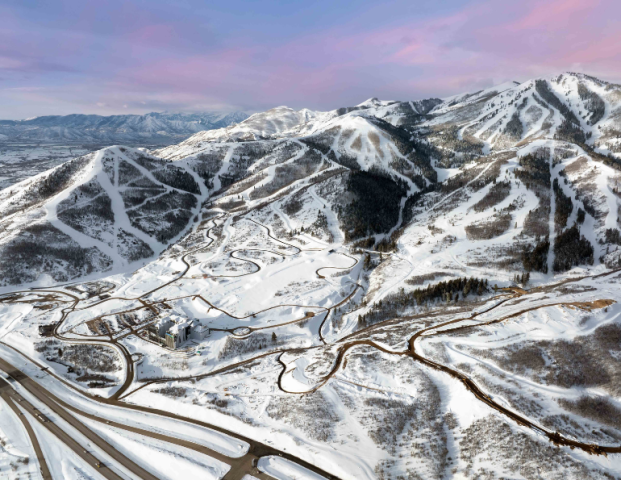In mid-November, crews at Utah’s Deer Valley Resort were working around the clock to complete “Phase 1A” of the ambitious Deer Valley East expansion. The plan was to open three new lifts, 21 new runs, and about 300 additional acres by late December, almost a full year earlier than planned. Phase 1 will more than double the resort’s skiable acreage by 2025-26.
It wasn’t the intention for any new terrain to open this season, says Deer Valley VP of mountain operations Steve Graff, who’s been at the resort for 32 years. “But adding nine or ten lifts in two years (via Phase 1 of the expansion) is substantial,” he says. “We saw the writing on the wall.” When the team started getting into the heavy construction mid-summer, “the reality came that we might be able to pull this off.”
When complete, the entire expansion will encompass 16 new lifts including a gondola, 135 new ski runs, and 3,700 added acres of skiable terrain. If it were a standalone resort, it would be the largest new public U.S. ski area built in about a half century. Combined, Deer Valley’s total skiable acres will be 5,726.
The expansion taps previously undeveloped land that lies to the east between the existing resort and Route 40 and to the south of Bald Mountain, essentially creating mid-mountain ski lifts out of some that had once been at the resort’s boundary.
While Deer Valley is responsible for building and managing the ski infrastructure, thanks to a 2023 deal that will allow it to lease the land and brand it Deer Valley, other elements of the expansion, including the new East Village base area, retail space, a 68,000-square-foot rec center, and three luxury hotels, will fall under the purview of New York-based landowner/developer Extell.
“We’re going to do what we do well, which is run the ski area, and they will take the lead on the village and lodging,” says Deer Valley president Todd Bennett. “We want to make sure that between our organizations, it feels like one seamless experience.”
HISTORY
The history between Deer Valley and what had been dubbed the “Mayflower” land after a previous owner spans decades, says Chris Cushing, principal of planning and design firm SE Group. Cushing’s father, Joe, created the original master plan for Deer Valley back in 1970. “Part of that was extending the lifts down to what’s now the East Village,” says Cushing. “The whole notion of having a portal to Deer Valley from the Mayflower side has been there since the beginning.”
Yet for a variety of reasons, not much happened for years. In the early ’70s, the owners of the Mayflower parcels—four total—weren’t interested, says Cushing. Later, some would periodically approach Deer Valley about connecting their individual pieces of land, but that would have required a lift and a skiway to get people back down the valley. “Deer Valley wasn’t interested in that,” he adds. “It wasn’t a ski expansion, just access to real estate.”
Fast forward to 2013. Some of the parcels had changed hands, and, for the first time, the landowners were on the same page about working with Deer Valley to connect a new ski area. Expansion planning was underway. SE Group had drawn up an expansion plan when Extell began to purchase the parcels, eventually amassing 7,000 acres total over several years and shifting direction.
“It was much more land than in 2013,” says Cushing, “so we came up with a master plan for a much bigger ski area that could either be stand-alone or an extension of Deer Valley.”
Graff notes that former Deer Valley COO Bob Wheaton “had been meeting with the Mayflower folks going back 15 or 16 years.” Once Extell was in the mix, he says, “We always knew that these folks were going to be our neighbors, so prior to any operating agreement, my bosses told me to do whatever I could to help them have the best product possible. Knowing we were going to be connected, we had a vested interest in helping to make it the best we could.”
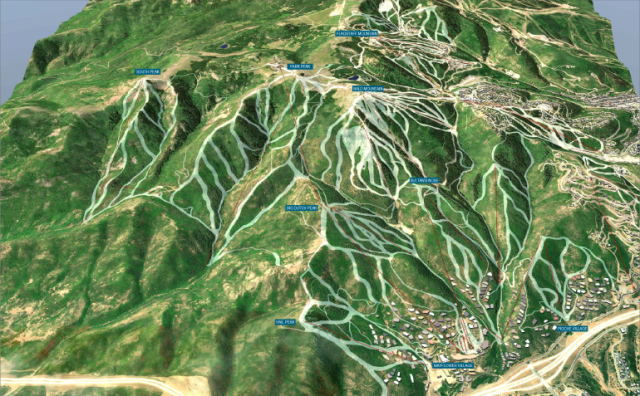 A digital overlay of the planned new trails (shaded light green) over the topography of the expansion area. Existing Deer Valley terrain is at right.
A digital overlay of the planned new trails (shaded light green) over the topography of the expansion area. Existing Deer Valley terrain is at right.
CONSTRUCTION
Grading, clearing, blasting, and prep work has been going on since at least 2019, says Graff, but a lion’s share of the on-hill work was done in 2024: power, infrastructure, water, sewer, and more.
Because of the massive scale of the job, Deer Valley tapped contractors from the oil and gas industry who worked at Mach speed to accommodate the expedited timeframe. “The reality is this project is so big, most of our existing contractors didn’t have the scope to do something this large,” says Graff. “Snowmaking alone will require putting in 40 miles of pipe in two years.”
Snowmaking. It was exciting to see, he says. “What they accomplished this summer in terms of snowmaking alone, I’ve never seen anything like it. They can put in five times as much snowmaking because of their equipment, like massive trenching machines that can go through solid rock, and weld hundreds of feet of pipe together.”
All told, the resort will add 615 acres of all-new, state-of-the-art snowmaking with an anticipated capacity of around 10,000 gallons per minute. This includes about 1,200 HKD sticks and 155 TechnoAlpin fans, all fully automated.
Though TechnoAlpin guns are traditionally yellow, these are Deer Valley green. “We got them painted green,” says Graff. “You can do that when you buy 155 of them.”
The 40 miles of new pipe—“a staggering number,” he notes—will be installed over two years, bringing total snowmaking pipe with the existing resort system to about 70 miles. The resort is installing coated steel pipe for water and HDPE for air lines.
Deer Valley East will be a standalone snowmaking system with interfaces to the existing resort. The new snowmaking system won’t be online until 2025-26, but this season about 100 of the HKD sticks will be integrated into Deer Valley’s existing snowmaking system, along with 238 other HKD guns that were installed last winter on Deer Valley East terrain.
“For someone like me in mountain operations who’s been doing this my whole life, what an opportunity,” says Graff. “The scale of everything going in, like a snowmaking system that has 10,000-gallon-per-minute pumping capacity, it’s all just staggering. When we combine the existing Deer Valley with our expansion, we will have 50 million gallons of capacity in our (three snowmaking) ponds and will be able to blow 20,000 gallons a minute.”
Lift infrastructure. The ski runs for Phase 1 had largely been built by November and lift alignments mostly set, says Cushing. Phases 1A and 1B of the expansion call for nine or 10 lifts by the 2025-26 season, with an undetermined timeframe on the final six. All will be Doppelmayr.
Up and running for 2024-25 are the Keetley Express, Aurora, and Hoodoo Express lifts, which all originate from the new East Village. Keetley, a D-Line six-pack bubble with heated seats—its name a mining reference, like many elements at Deer Valley—will provide the first of four access points to the original resort and will take riders to the Sultan Lift at Deer Valley. Hoodoo is a Uni-G detachable quad, which serves the East Village beginner area, and Aurora is a fixed-grip quad with a loading conveyor.
In 2025-26, Phase 1B will add a flagship East Village gondola, a 10-passenger D-Line; the Pinion Express, a D-Line detachable six-pack; the Galena express, a D-Line quad; and several more Uni-G quads. The gondola will provide a two-stage connection from the East Village to Park Peak in 2025 and will eventually be a four-stage, connecting to the Snow Park side of Deer Valley.
Cushing says new lift technology has allowed more terrain to be served with fewer, longer, and more efficient lifts. “The expansion has 16 lifts; Deer Valley has 21 lifts” for about 2,000 acres of terrain, he says. “The lift alignment has been configured so that they can serve as much terrain as possible and limit initial costs.”
Teams will take a wait-and-see approach on the remaining six lifts, says Graff. “Like any resort’s master plan, some lifts are going to be capacity dependent. We will gauge how skier visits increase after the first 10 lifts are in, then see what happens.”
Likewise with some of the terrain. Plans for an 800-acre area of expert terrain called South Peak, which will eventually have two lifts, are undetermined, but it will not be developed by 2025.
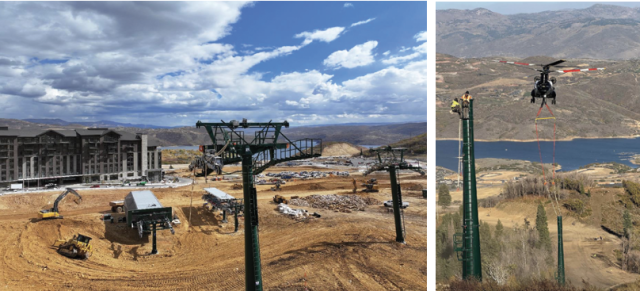 Left to Right: Two of the three new lifts out of the base area serve beginner terrain, while the Keetley Express (left terminal) serves as the first connector to Deer Valley’s existing terrain; Flying towers for one of the five new chairlifts installed at Deer Valley East over the summer, three of which opened this winter.
Left to Right: Two of the three new lifts out of the base area serve beginner terrain, while the Keetley Express (left terminal) serves as the first connector to Deer Valley’s existing terrain; Flying towers for one of the five new chairlifts installed at Deer Valley East over the summer, three of which opened this winter.
Grooming. As with the lifts, grooming will be approached as a roll-out. Graff says four machines were purchased to cover the expanded terrain this year, bringing the trail-grooming fleet to 21 in addition to three winches, one work cat with a basket, and a handful of loaners, including some cabin cats, to demo from Prinoth and PistenBully—a benefit of buying so much hardware, says Graff.
Deer Valley has traditionally been a Prinoth mountain, says Graff, but now has a mixed fleet after it purchased its first PistenBullys a few years ago. “I think we have almost every cat model that both manufacturers make.”
This year, groomers will be out in those machines doing “real-world” testing to see what sticks. “We are taking this opportunity of massive growth to evaluate how we do things,” says Graff. “We are going to look at everything available and what’s going to work the best for us.”
The resort will also utilize SNOWsat technology. This fall, it collected fly-over LiDAR imaging of the existing resort and portions of the expansion, which was loaded into five snowcats this season to start collecting data. Graff hopes it will help reconcile differences of opinions between groomers and snowmakers as well as provide a level of efficiency and savings. “I’m very optimistic that we can be a lot more efficient with our snowmaking and grooming if operators can get the data about the depths of snow in front of them,” he says. “Having some real data to inform those decisions will be really helpful.”
Parking. Another important, albeit less dramatic, part of the expansion is 1,200 new parking spaces, with about 500 coming online this season. All told, they will nearly double Deer Valley’s existing 1,400-space parking capacity (1,700 with street parking), located at the Snow Park base area.
The parking will provide visitors another entry point and divert skier traffic away from often-congested Park City. “You can come from Salt Lake, Heber, the airport, and parts of Midway to get to the Deer Valley East Village and you won’t hit a stoplight,” says Bennett.
Though not part of Deer Valley’s workload, SE Group is also on the team for Extell’s East Village base area development and worked with its residential planning team to design ski access from residential lots. The resort village is being developed by Extell, though Deer Valley will have a skier services building there.
MIDA. Another aspect of the expansion is the partnership between Extell and Utah’s Military Installation Development Authority (MIDA), in which service members can receive discounted room rates at the new East Village luxury Grand Hyatt Deer Valley. While the partnership is between MIDA and Extell, Deer Valley is offering discounted tickets, rentals, and lessons to support these hotel bookings as a package deal.
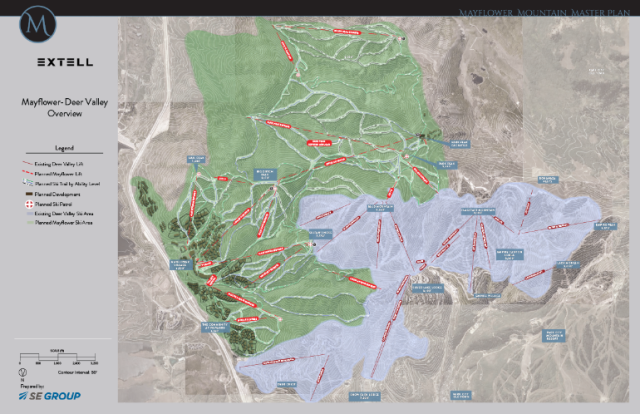 This overview shows the scale of the expansion property (green) compared to the existing resort (gray).
This overview shows the scale of the expansion property (green) compared to the existing resort (gray).
OPERATIONS AND STAFFING
When the expansion is fully up and running, an estimated 1,500 additional staff will be required during the height of winter. Deer Valley employed about 3,000 staff total last year. Mountain ops alone is estimated to double in size, from 700 to 1,400 employees, says Graff.
Growth opportunities. “Hiring that many new people could dilute your culture, so we’re focusing on taking the current leadership and growing them,” he says. For mountain ops, this means setting up a supervisory structure and shifting managers around “so it won’t be all new people on the expansion side. We’re trying to get supervisors hired and trained in our culture so new hires get the leadership they need and are prepared.”
Graff notes the mountain ops departments have been fully staffed in recent years. It helps, he says, when people see an opportunity for growth. “It’s really highlighted the need in the industry to focus on technical skills like snowmaking, grooming, patrol, skills like that.”
Maintaining the culture. For Bennett, it’s about “stretch assignments.” “The most important thing in leadership development is focusing on the Deer Valley culture and what got us to where we are today,” he says. “As we double the size of the resort, how are we growing and stretching our leaders? We know that if we do those well—maintaining the culture and growing our leaders—the smaller challenges will be real, but better aligned to fall into place.”
Customer satisfaction is a cultural tenet, as well. “You think about Whistler-Blackcomb or Park City-Canyons—there have been mergers and acquisitions of neighboring resorts. But our culture is so important to us and who we are that we were adamant from day one that this was going to be Deer Valley, not ‘Mayflower’ and ‘Deer Valley,’” says Graff. “It’s important that it feels like Deer Valley when you ski over.”
Design. Having the same family design the new and original terrain helped it click, he says. “The way the runs are designed in the expansion are similar to how existing Deer Valley runs were designed, so it’s all very natural.”
One thing to consider in a project of this magnitude, Graff adds, is to “get end-users involved in the process as early possible.” Operations teams—snowmakers, patrol, and groomers—were involved in the design and construction processes from the get-go. Because of this, during the busy summer, the construction had no major alterations, “just minor tweaks that will make our lives as operators much better down the road.”
Deer Valley will continue to limit the number of skiers on the mountain per day and require reservations as in the past, though it’s unclear exactly what that will look like. “We’ll have to see how it balances out and will err on being conservative,” says Bennett. “We expect the number of skiers on the mountain to go up, but it’s got to be done in a more measured way.”
The operation, says Bennett, was examined through the constraints of different things: parking spaces, line length, indoor and outdoor F&B seating, density of skiers on trails. “We’re always trying to balance that, and we’re looking at that through the same lens. New lifts and new trails should reduce the amount of time in line, but we’ll have more parking, so we’re trying to find that balance.”
Until then, the team continues to successfully balance every aspect of this gargantuan project.
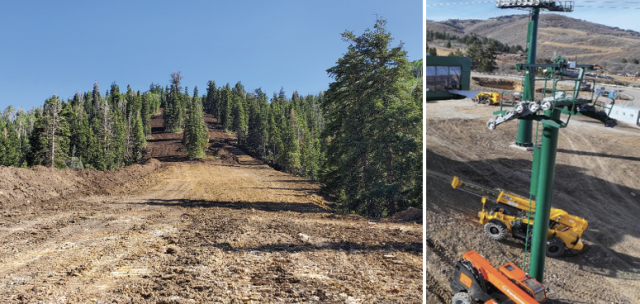 Left to Right: Trail clearing began in 2019, following a design by SE Group, which also designed the original Deer Valley terrain, so the ski experience transitions naturally from existing to new terrain; The top terminal of one of three new lifts that opened this winter.
Left to Right: Trail clearing began in 2019, following a design by SE Group, which also designed the original Deer Valley terrain, so the ski experience transitions naturally from existing to new terrain; The top terminal of one of three new lifts that opened this winter.
DEER VALLEY EAST: BY THE NUMBERS
Once the entire expansion is complete, which is still TBD at this time, it will add the following to Deer Valley’s current operation:
SKIABLE ACRES: 3,700
TRAILS: 135
LIFTS: 16
SNOW GUNS: 1,200 STICKS, 155 FANS
SNOWMAKING PIPE: 40 MILES (211,200 FEET)
SNOWMAKING ACRES: 615
PUMPING CAPACITY: 10,000 GPM
SNOWMAKING WATER STORAGE: 10 MILLION GALLONS
SNOWCATS FOR 2024-25: 4
PARKING SPACES: 1,200
STAFF: 1,500 (700 IN MOUNTAIN OPS)





